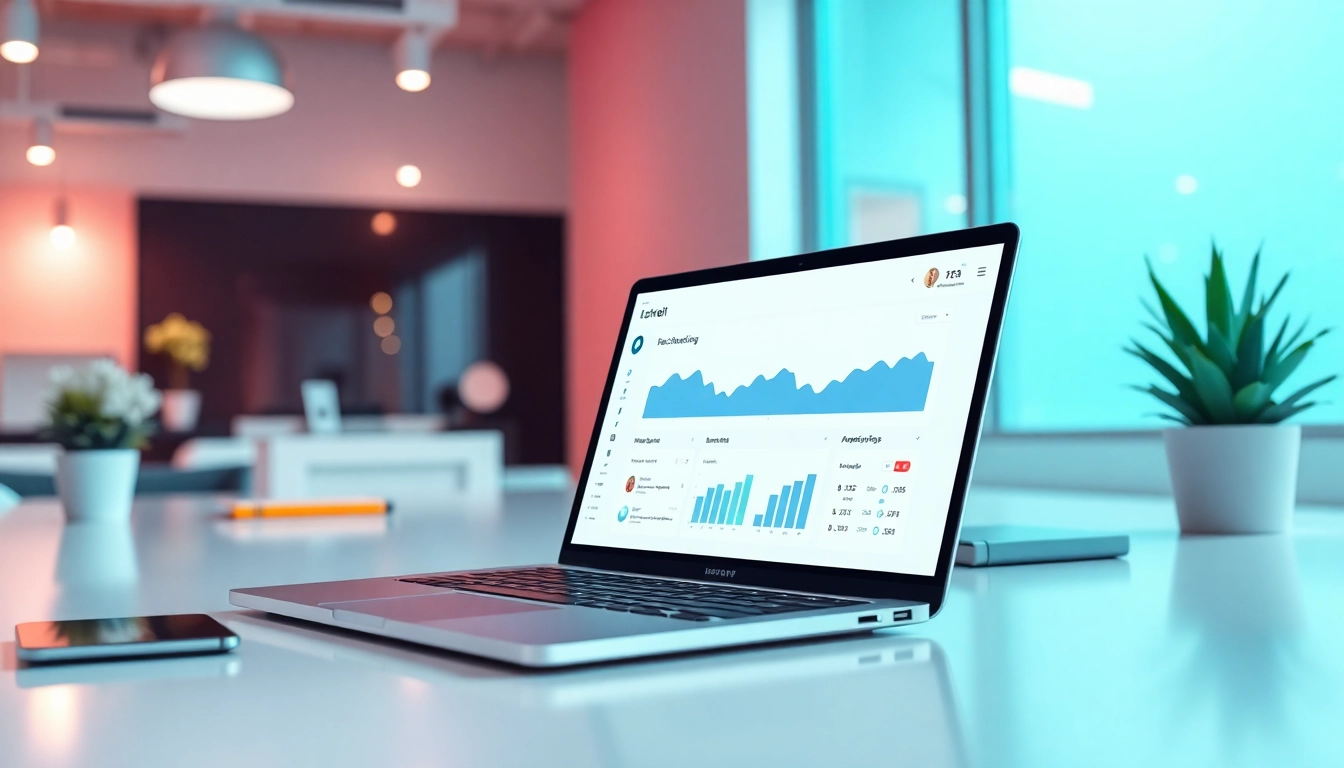Understanding Competitive Intelligence for Sales
Definition and Importance of Competitive Intelligence
In the ever-evolving landscape of sales, businesses must be equipped with the right knowledge to navigate competition effectively. Competitive intelligence (CI) refers to the systematic process of collecting and analyzing data related to competitors, market trends, and customer preferences. This practice is crucial for sales teams, as it empowers them to make informed decisions, adapt strategies, and maintain a competitive edge. Implementing robust competitive intelligence for sales can enhance a team’s ability to better address customer needs and outmaneuver other players in the market.
Key Components of Competitive Intelligence for Sales
Effective competitive intelligence encompasses several components:
- Market Analysis: Understanding the market dynamics, including trends, opportunities, and threats.
- Competitor Profiling: Identifying key competitors, their strengths and weaknesses, product offerings, pricing strategies, and marketing approaches.
- Customer Insights: Gathering data on customer behaviors, preferences, and feedback regarding competitors’ products or services.
- Sales Strategy Analysis: Evaluating the effectiveness of current sales strategies in light of competitive factors.
By synthesizing these components, sales teams can develop actionable strategies that align with current market conditions and customer expectations.
Common Misconceptions About Competitive Intelligence
There are several misconceptions surrounding competitive intelligence:
- CI is Only for Large Corporations: Many believe that competitive intelligence is the domain of large enterprises with significant resources. In reality, small and medium-sized businesses can greatly benefit from CI practices.
- CI is Just About Data Collection: While gathering information is vital, the real value of CI lies in analyzing the data to derive actionable insights.
- CI is Ethical Spying: Competitive intelligence should not be confused with unethical practices like industrial espionage. It relies on public data and ethical sourcing of information.
Addressing these misconceptions helps organizations understand the true value of competitive intelligence in shaping effective sales strategies.
Implementing Effective Competitive Intelligence Practices
Conducting Competitive Analysis
Conducting a competitive analysis is the cornerstone of competitive intelligence. The process involves several steps:
- Identify Key Competitors: Determine who your primary competitors are in the market. This can include direct competitors, indirect competitors, and emerging players.
- Data Collection: Gather data from various sources such as company websites, financial reports, customer reviews, social media, and industry publications. Utilizing tools can streamline this process.
- SWOT Analysis: Conduct a SWOT analysis (Strengths, Weaknesses, Opportunities, Threats) for each competitor. This framework helps in understanding their positioning and strategy.
- Analyze Market Position: Assess where each competitor stands in terms of market share, product range, pricing, and customer perception. This information helps identify potential gaps and opportunities for your business.
Once you’ve analyzed competitors, the next step is to integrate these insights into your sales planning and strategy.
Integrating Competitive Intelligence into Sales Processes
For competitive intelligence to be truly effective, it must be integrated into the sales process. Here are key strategies:
- Developing Sales Playbooks: Create comprehensive playbooks that outline information about competitors, their product offerings, and strategies for positioning your products favorably in comparison.
- Training Sales Teams: Regular training sessions should be conducted to ensure sales teams are equipped with the latest intelligence insights. This knowledge helps them handle objections and position their offerings against competitors successfully.
- Feedback Loops: Establish feedback mechanisms where sales teams can share their experiences and insights from client interactions related to competitors. This creates a more dynamic system of intelligence.
Integrating these practices enables sales teams to become more agile, informed, and responsive to market dynamics.
Tools and Resources for Competitive Intelligence
Numerous tools and resources can facilitate competitive intelligence efforts:
- Data Analytics Platforms: Tools such as Google Analytics, market research platforms, and social media analytics can provide valuable insights into competitor behaviors and trends.
- CRM Systems: Customer relationship management systems can track interactions with competitors and capture intelligence gathered from sales teams and customers.
- Competitive Intelligence Software: Specialized software solutions can automate data collection and analysis, helping teams to focus on strategic decision-making.
Choosing the right tools ensures that competitive intelligence initiatives are streamlined and effective.
Leveraging Competitive Intelligence for Enhanced Sales Performance
Identifying Market Trends and Opportunities
One of the primary benefits of competitive intelligence is its ability to uncover market trends and opportunities. This can be achieved through:
- Trend Analysis: Regularly monitor industry reports, news articles, and market surveys to identify emerging trends that might affect your business.
- Customer Feedback: Analyzing customer feedback not only on your products but also on competitors can highlight opportunities for improvement or innovation.
- Networking: Engage with industry experts and stakeholders to gain insights into potential market shifts and customer demands.
By staying ahead of trends, organizations can seize opportunities before their competitors do.
Adapting Sales Tactics Using Competitive Insights
Sales tactics should evolve based on intelligence gathered from competitors. Key approaches include:
- Positioning Adjustments: Modify product positioning and value propositions according to the competitive landscape. Highlight unique features that differentiate your offers.
- Pricing Strategies: Use insights on competitor pricing to inform your pricing strategies. This may involve competitive pricing, discounts, or offering value-added services.
Adapting these tactics increases the effectiveness of sales efforts and improves the likelihood of winning deals.
Measuring the Impact of Competitive Intelligence
To justify investments in competitive intelligence, organizations must establish metrics to measure its impact. Consider tracking:
- Win Rates: Assess how often your sales teams win against competitors and whether this changes after integrating CI practices.
- Sales Cycle Length: Monitor whether the sales cycle decreases as teams become more knowledgeable and prepared for competitor objections.
- Customer Retention Rates: Track changes in customer loyalty and retention, indicating how well your offerings meet market demands.
By quantifying the influence of competitive intelligence, organizations can refine their strategies accordingly.
Common Challenges in Utilizing Competitive Intelligence for Sales
Data Overload and Analysis Paralysis
In an age where data is abundant, one major challenge is data overload. Sales teams can become overwhelmed by the sheer volume of information, leading to analysis paralysis. To mitigate this:
- Prioritize Data: Focus on data that aligns with your objectives. Identify the most relevant metrics that impact your sales processes.
- Utilize Dashboards: Implement data visualization tools to present insights in a clear and actionable manner, making it easier to digest and act upon.
By simplifying data presentation, teams can make quicker, more informed decisions.
Ensuring Data Accuracy and Relevance
A common concern is the accuracy and relevance of collected data. To enhance data reliability:
- Source Verification: Always verify the credibility of your data sources. Rely on reputable publications, industry reports, and market research.
- Regular Updates: Continuous monitoring and regularly updating your data will help ensure that the intelligence remains relevant amidst changing market conditions.
Ensuring data integrity fosters confidence in the decision-making process.
Addressing Team Resistance to New Strategies
Implementing new competitive intelligence strategies can sometimes meet with resistance from team members. To overcome this challenge:
- Involve Teams in Development: Encourage input from sales teams when developing CI strategies. When they feel involved, they are more likely to embrace changes.
- Clear Communication: Explain the benefits of CI practices and how they can enhance individual performance and results.
Fostering a culture of collaboration and open communication ensures greater acceptance of innovative practices.
Future Trends in Competitive Intelligence for Sales
The Role of Technology and Automation
The future of competitive intelligence heavily hinges on advancements in technology and automation. Organizations can expect:
- Enhanced Analytical Tools: As technology progresses, tools for data collection and analysis will become more sophisticated, enabling deeper insights with less manual effort.
- AI and Machine Learning: The integration of artificial intelligence in CI can help in rapidly processing data and predicting trends, enabling proactive responses to market changes.
Embracing these technological trends will empower sales teams to operate more effectively in a competitive environment.
Predictive Analytics in Competitive Intelligence
Predictive analytics will play an increasingly significant role in competitive intelligence, allowing teams to:
- Forecast Market Trends: Using historical data to predict future market developments, enabling businesses to adapt ahead of time.
- Customer Segmentation: Identify potential customer segments that may respond favorably to specific marketing strategies based on predictive insights.
Harnessing predictive analytics can make sales approaches much more strategic and data-driven.
Preparing for Evolving Market Dynamics
The market landscape is continuously shifting due to various factors, including consumer behavior, technology, and global events. To stay ready:
- Adopting Agile Practices: Organizations should embrace agility in their CI processes, ensuring that they can pivot quickly in response to new information.
- Continuous Learning: Foster a culture of learning and adaptability within the sales team, encouraging constant update and application of knowledge.
Preparing for change not only aids in maintaining relevance but also creates opportunities for growth.



